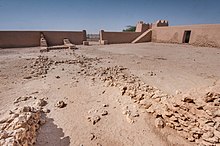HD 173417
HD 173417| 관측 데이터 Epoch J2000.0 이쿼녹스 J2000.0 | |
|---|---|
| 별자리 | 리라 |
| 우측 상승 | 18h 43m 51.59217s[1] |
| 탈위임 | +31° 55′ 35.8058″[1] |
| 겉보기 크기 (V) | 5.68[2] |
| 특성. | |
| 스펙트럼형 | F1III-IV[3] |
| B-V색지수 | +0.360±0.004[2] |
| 변수형 | 상수[4] |
| 아스트로메트리 | |
| 방사 속도 (Rv) | -3.26±0.57km[1]/s |
| 고유 운동 (μ) | RA: −32.768[1]mas/yr Dec.: -125.812마스[1]/yr |
| 시차 (π) | 19.27 ± 0.60[1] 마스 |
| 거리 | 169 ± 5 리 (52 ± 2 pc) |
| 절대치수 (MV) | 2.17[5] |
| 세부 사항 | |
| 미사 | 1.60[6] M☉ |
| 반지름 | 2.243[2] R☉ |
| 루미도 | 10.407[2] L☉ |
| 표면 중력 (log g) | 3.91[6] cgs |
| 온도 | 6,928[2] K |
| 금속성 [Fe/H] | -0.21[6] 덱스 |
| 회전 속도 (v sin i) | 53.9±2.7km[7]/s |
| 나이 | 1.70[6] Gyr |
| 기타 지정 | |
| 데이터베이스 참조 | |
| 심바드 | 자료 |
HD 173417은 라이라 북쪽 별자리에 있는 단일 별이다[9].그것은 밝은 별 셀리아크의 남서쪽으로 약 2도 정도 위치하며,[2] 겉으로 보이는 시각적 크기 5.68로 육안으로 희미하게 보인다.[10]이 별까지의 거리는 시차 측정에 근거하여 약 169광년이며, 반지름 속도 -3 km/s로 천천히 더 가깝게 표류하고 있다.[1]
이 별의 별 분류는 F1이다.III-IV,[3] 진화하는 항성과 아거성 및 거성의 혼합된 광도 특성을 조화시킨다.17억년 된 것으로 금속성이 낮고 54km/s의 비교적 높은 예상 회전속도를 가지고 있다.[7]이 별은 태양의 1.6배[6], 태양의 반지름 2.2배의 질량을 가지고 있다.그것은 유효 온도 6,928 K로 광권으로부터 태양의 10배 이상의 광도를 방출하고 있다.[2]
참조
- ^ a b c d e f g Brown, A. G. A.; et al. (Gaia collaboration) (August 2018). "Gaia Data Release 2: Summary of the contents and survey properties". Astronomy & Astrophysics. 616. A1. arXiv:1804.09365. Bibcode:2018A&A...616A...1G. doi:10.1051/0004-6361/201833051.이 소스에 대한 가이아 DR2 기록 VizieR.
- ^ a b c d e f g Schofield, Mathew; et al. (2019), "The Asteroseismic Target List for Solar-like Oscillators Observed in 2 minute Cadence with the Transiting Exoplanet Survey Satellite", The Astrophysical Journal Supplement Series, 241 (1): 12, arXiv:1901.10148, Bibcode:2019ApJS..241...12S, doi:10.3847/1538-4365/ab04f5, S2CID 119481586.
- ^ a b Cowley, Anne; Fraquelli, Dorothy (February 1974), "MK Spectral Types for Some Bright F Stars", Publications of the Astronomical Society of the Pacific, 86 (509): 70, Bibcode:1974PASP...86...70C, doi:10.1086/129562.
- ^ Breger, M.; et al. (May 1981), "A Search for Maia Variables", Information Bulletin on Variable Stars, 1966: 1, Bibcode:1981IBVS.1966....1B.
- ^ Anderson, E.; Francis, Ch. (2012), "XHIP: An extended hipparcos compilation", Astronomy Letters, 38 (5): 331, arXiv:1108.4971, Bibcode:2012AstL...38..331A, doi:10.1134/S1063773712050015, S2CID 119257644.
- ^ a b c d e Casagrande, L.; et al. (June 1, 2011), "New constraints on the chemical evolution of the solar neighbourhood and Galactic disc(s). Improved astrophysical parameters for the Geneva-Copenhagen Survey", Astronomy and Astrophysics, 530: A138, arXiv:1103.4651, Bibcode:2011A&A...530A.138C, doi:10.1051/0004-6361/201016276, ISSN 0004-6361, S2CID 56118016.
- ^ a b Reiners, Ansgar (January 2006), "Rotation- and temperature-dependence of stellar latitudinal differential rotation", Astronomy and Astrophysics, 446 (1): 267–277, arXiv:astro-ph/0509399, Bibcode:2006A&A...446..267R, doi:10.1051/0004-6361:20053911, S2CID 8642707.
- ^ "HD 173417". SIMBAD. Centre de données astronomiques de Strasbourg. Retrieved October 16, 2007.
- ^ Eggleton, P. P.; Tokovinin, A. A. (September 2008), "A catalogue of multiplicity among bright stellar systems", Monthly Notices of the Royal Astronomical Society, 389 (2): 869–879, arXiv:0806.2878, Bibcode:2008MNRAS.389..869E, doi:10.1111/j.1365-2966.2008.13596.x, S2CID 14878976.
- ^ Sinnott, Roger W.; Perryman, Michael A. C. (1997), Millennium Star Atlas, vol. 3, Sky Publishing Corporation and the European Space Agency, p. 1175, ISBN 0-933346-84-0.

